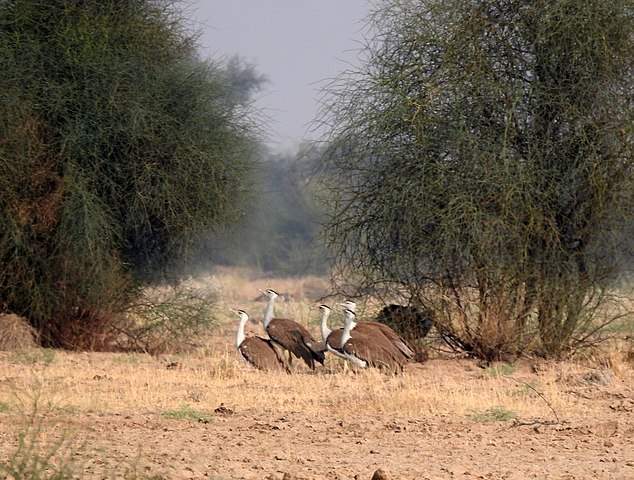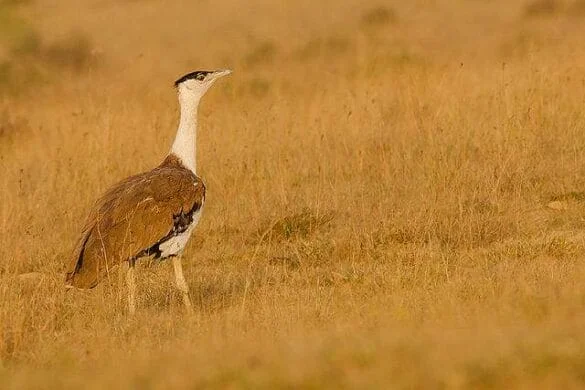Can you take your eyes off this magnificent bird? It is truly great. This is the Great Indian Bustard. The lovely brown and white combination suit the bird’s size.
It was once a thriving bird. It invited birders from all parts of the world to spot it in a very few places in India.
Sadly, it is nearing extinction for various reasons.
Where to Spot the Great Indian Bustard?
As of now, the Great Indian Bustard was reported seen at the following places. Wildlife travel enthusiasts would welcome this informative post.
-
Great Indian Bustard Sanctuary (Jawaharlal Nehru Bird Sanctuary)
This is one of the prime sanctuaries that try to protect the fantastic bird of Otididae species.
It is located in Sholapur, Maharashtra.
Looking at the bird’s massive size, some people are the under the wrong impression that it is a flightless bird.
On the contrary, the Great Indian Bustard can fly like any other Otifidae. This particular bird can attain a maximum speed of nearly 100 km per hour!
Hunting for the bird puts them in danger. I read, even habitat loss is one of the reasons for the bird to get listed as endangered.
I cannot believe it. India’s extremely diverse geography is fit for any kind of birds, animals, and reptiles to thrive.
Did you notice a patch of black on the bird’s nest? Here, watch the bird’s photo again.

It is a strong identity of the bird. Its body is strong, and appears beautiful when it is walking, with head straight, and eyes focused.
I could not find an appropriate photo of the Great Indian Bustard’s walking posture but it will look something below.
During the mating season, the bird lets out a strong call with the aid of a gular pouch, similar to the Frigate Bird.
The bird was once found in almost all parts of India except the Himalayas, and the Western Ghats. I believe the bird thrives in hot and arid conditions.
However, today, it is largely found in and around the That Desert in Rajasthan.
-
Kutch Bustard Sanctuary, Gujarat
It is also reported in Gujarat’s western coast, where it is generally very hot.
To be more precise, Abdasa Taluk in Kutch district is where, some of them were seen.
Mandvi is another Taluk where the bird was seen.
The sanctuary’s flora includes tall grass amidst which the bird lives.
Yes, the Great Indian Bustard is essentially a ground bird. This is so unlike the other raptures that prefer cliffs.
Jamnagar in Gujarat has also a sanctuary for this incredible bustard.
The Great Indian Bustard has thirty aliases. Here in Kutch, it is called “Ghorad”.
You can spot another species known as Bengal Florican in this sanctuary.
One more beautiful bustard from Africa lives here. It is called Houbara Bustard.
Ardent bird watchers can spot numerous birds in this sanctuary, including the graceful pelicans, harriers, and cranes.
Aren’t they tall, and attractive?
-
Desert National Park
It is another place to find the Great Indian Bustard. This NP is quite large, covering an area over 3,100 sq. km.
The nearest cities include Jaisalmer, and Barmer in Rajasthan.
-
Ghatigaon Wildlife Sanctuary
This 500 sq. km sanctuary for wildlife is situated near the textile city of Gwalior, Madhya Pradesh.
You can spot the bustard here with some patience. The population is rather thin in this wildlife park.
-
Karera Wildlife sanctuary
The great Indian Bustards are found to be living here. The park is located in Shivpuri district.
To view the bustards, go to Jhansi city in Madhya Pradesh by train either from Bhopal or New Delhi.
From Jhansi, hire a taxi to go to the Karera wildlife park. The distance to be covered is roughly 50 km.
This park is home to more than 250 species of birds.
The sanctuary was mainly established to protect the Great Indian Bustard.
Chidiya as the bird was locally addressed, is almost extinct. May be a lonely couple can be rarely seen inside the sprawling forest.
Karera wildlife sanctuary is a good place to see the lovely, Spoonbills.
-
Rollapodu wildlife sanctuary
Once again, it was developed to protect the thriving population of the Great Indian Bustards.
Rollapodu WS is located in Nandyal district, Andhra. The nearest town is Nandyal, at 40 km from the bustards’ habitat.
One can also spot the black ‘lesser florican’, a species of bustard, here.
This Andhra Pradesh sanctuary attracts a lot of migratory birds. Among them, the Demoiselle Cranes are beautifully plumaged.
Note:
The Great Indian Bustard was once considered as Indian national Bird but gave up in place of the gorgeous peacocks.
They are rare and endangered birds. Nonetheless, it still attracts wildlife tourists from the world.


